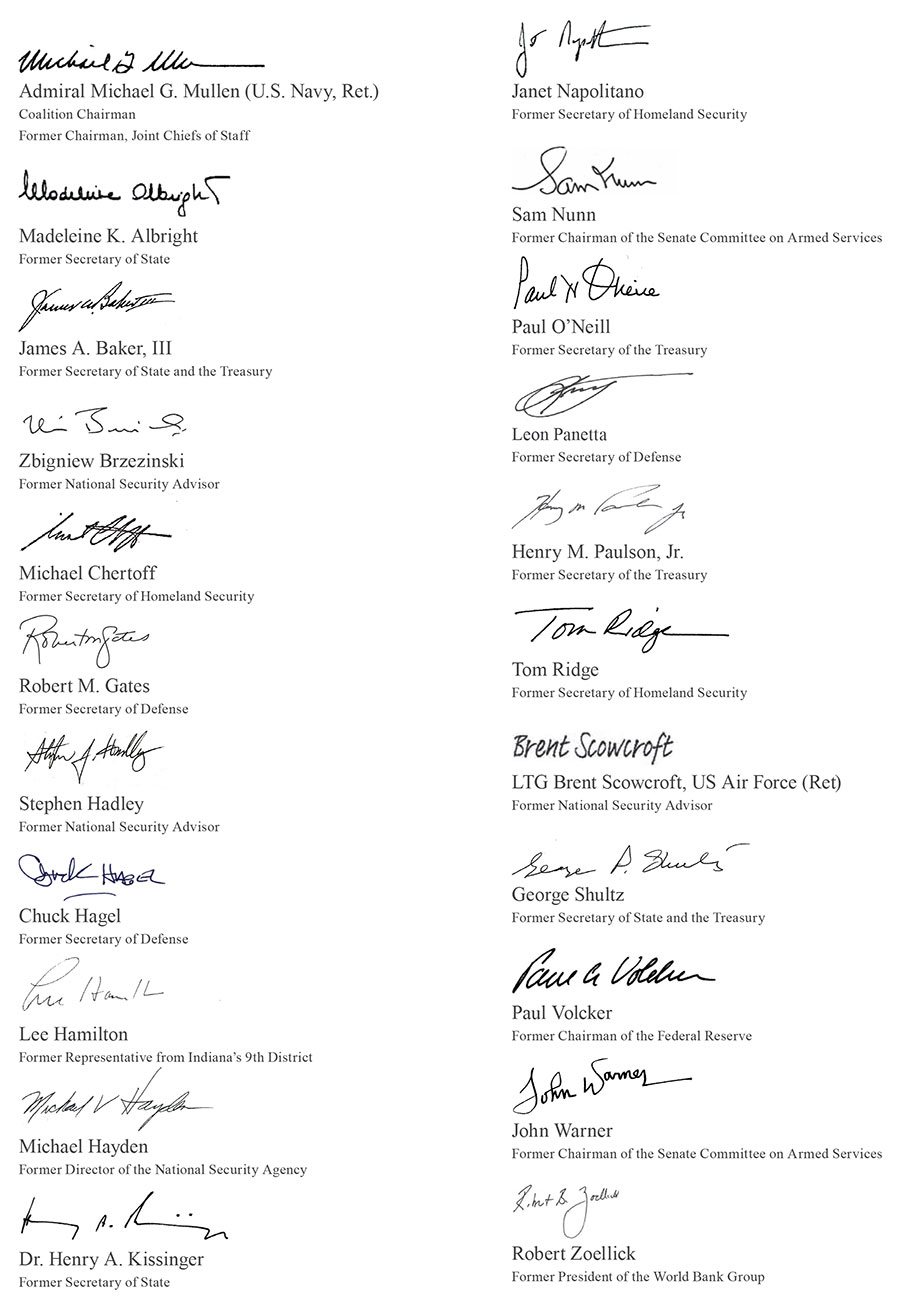Strength at Home and Abroad
Ensuring America’s Fiscal and National Security
May 10, 2016
A new statement from the Coalition for Fiscal and National Security
Economic growth, and the sustainable fiscal policies that promote it, are at the root of our nation’s global leadership and national security. We are former senior government officials who have served during eight presidential administrations, Democratic and Republican, and former leaders in Congress from both parties. With renewed threats placing our security in the spotlight, we have come together for a second time to draw our country’s attention to how our national security is fundamentally linked to the fiscal sustainability of our federal budget, and to the urgent need to update and re-prioritize our defense and foreign policy strategies.
Despite the partisan and divisive campaign season, we must not lose sight of the core values we share. The men and women who defend and represent our country, and all the American people, deserve the sensible solutions and smart planning that will enable our country to seize opportunities and surmount challenges, to invest in the future of our citizens at home, and to maintain the leadership position of the United States in the world. We endorse the policy measures outlined below, as Republicans and Democrats, conservatives and liberals, civilian and military leaders — as Americans.
Fiscal Security
As individuals who have served the nation in both international and domestic leadership roles, we continue to believe that our long-term debt is the single greatest threat to our national security. Despite the fact that current deficits have fallen, the federal debt is still projected to grow to unsustainable and dangerous levels. Over the next 25 years, the federal debt is projected to climb to 131 percent of GDP under current law — three times the average since World War II — or to a staggering 175 percent of GDP under alternative assumptions. This debt burden would slow economic growth, reduce income levels, and harm our national security posture. It would inevitably constrain funding for a strong military and effective diplomacy, and draw resources away from the investments that are essential for our economic strength and leading role among nations.
Putting our budget onto a sustainable path is thus a fundamental precondition for future prosperity and security. There are a number of important steps that we can and must take to stabilize our national debt.
We must make sensible changes to our essential entitlement programs to make sure they are viable for the long term. We need to preserve Social Security for the next generation and ensure that it provides adequate protections for our most vulnerable citizens.
According to the Social Security Trustees, without changes in law, Social Security benefits could be cut by 21 percent when the trust fund is exhausted in 2034.
On healthcare, the U.S. spends more than twice as much per capita as the average developed country (OECD), but we have health outcomes that are no better, based on important indicators such as life expectancy and infant mortality. We have much more work to do to build on recent progress to control healthcare costs, while improving the quality of medical care.
Our tax system also needs a major overhaul — it has become overly complex, inefficient, and inadequate. Too many tax preferences distort the allocation of resources and largely benefit the well-to-do. Our corporate income tax system imposes the highest statutory tax rates among advanced countries, undermines our competiveness, and incentivizes companies to move overseas.
We also need to take steps to invest successfully in our future and boost the productivity of our workforce. U.S. leadership in a competitive global economy requires private and public investments to drive economic growth and productivity: effective education and training, development of new businesses, updated infrastructure, and a strong commitment to research.
Despite these key priorities, discretionary spending, which funds these investments, is projected to decline to its lowest levels in recorded history (as a percentage of GDP). This effectively reduces our investment in the next generation. Over the long term, rising debt and interest costs threaten to crowd out investments even further. As debt levels grow and rates rebound, interest payments on the debt are expected to triple, totaling $5.8 trillion over the next ten years. Getting our growing national debt under control is essential to ensuring that we have resources to invest in our own future.
Further, smart and fair immigration reform would help our fiscal outlook by bringing more productive young immigrants into the legal workforce. So would encouraging older workers to remain in the workforce longer instead of retiring.
By taking these steps sooner rather than later, we can put our debt on a sustainable course in a gradual and sensible manner, with reforms that need not violate the core principles of either party. Rather than careening toward a level of debt greater than the size of our economy, we should stabilize the debt as a share of the economy and put it on a downward path. Getting our fiscal house in order is essential to driving higher levels of economic growth and a continued leadership role for the U.S. in the world.
National Security
Since the release of our last report, we see various sources of intensified pressure from abroad. ISIS and other Al Qaeda successors aim to redraw the map of the Middle East and take the fight to the West at home; Russia is an increasing threat; China is engaged in a robust defense buildup amidst escalating territorial disputes; and both Iran and North Korea are destabilizing forces in their regions.
The budget framework that shapes American national security policy is hamstrung, most obviously by the thoughtless, and less than courageous, automatic spending constraints imposed by sequestration and the Budget Control Act. Across-the-board cuts are self-defeating because they are by definition non-strategic, and can hurt military readiness (which is the precursor to a hollow force) and eventually jeopardize our security. These cuts in defense spending will never solve the government’s fiscal crisis — they are a symptom of it.
Our own defense planning is wanting. Due to parochial interests and a lack of political will, we have failed to fully modernize our national security policies to reflect the complex challenges posed by the world today. In the current security environment, it is often sophistication and agility that matter more than might and size of force. Yet, too many of our old and unsustainable policies are still funded, jeopardizing the preeminence of both our military and the budget that sustains it. This inertia is a threat to our national defense—dated decisions about strategy, personnel, weapons systems, and infrastructure must be reassessed. We need a nimble and responsive national defense, one that is subject to reform.
Poor defense policy is a threat to the budget as well. Rising spending on military compensation, retirement benefits, and procurement will put unbearable pressure on the rest of the defense budget over the long term.
Absent reforms, the growth of these costs will either swell the defense budget unsustainably, or squeeze out other areas of national security spending, leading to a hollowing of the force.
Today, to be pro-defense must mean being pro-reform. America’s national security budget requires updating and rebalancing in order to sustain our strong military posture and global leadership role.
Update Our Strategic Priorities
We agree across party lines, as do most Americans, about the scope and breadth of the security challenges we face. Terror groups, such as ISIS, are an increasing threat to our allies abroad and our citizens at home. Major powers such as Russia and China are growing their militaries and heightening confrontational stances. Even middle powers such as Iran and non-state actors are rapidly gaining access to state-of-the-art technologies and new methods of warfare, such as cyberattacks. And in recent years we have seen how even very small forces can stymie traditional American force deployments and weapons systems.
With current and potential foes able to innovate rapidly, it is dangerously unacceptable to have a defense system in which old priorities stay on the books for decades because they are politically too hard to reform. At best, it squanders resources that are urgently needed elsewhere; at worst, it costs American and allied lives. We identify three areas in which Congress should grant the Secretary of Defense increased authorities:
- Eliminate superfluous or antiquated weapons systems ill-suited for the global security environment we now face;
- Close and re-align military facilities through a new round of Base Realignment and Closure (BRAC) and address workforce imbalances (described further below);
- Re-assess static deployments of troops and shift toward expeditionary deployments and temporary rotations of troops who would remain based at home.
A more nimble and responsive defense posture — one based on an updated assessment of strategic priorities — will result in more efficient use of resources, while also providing for a stronger national defense.
Poor defense policy is a threat to the budget as well. Rising spending on military compensation, retirement benefits, and procurement will put unbearable pressure on the rest of the defense budget over the long term.
Absent reforms, the growth of these costs will either swell the defense budget unsustainably, or squeeze out other areas of national security spending, leading to a hollowing of the force.
Today, to be pro-defense must mean being pro-reform. America’s national security budget requires updating and rebalancing in order to sustain our strong military posture and global leadership role.
Increase the Capability and Role of Smart Power
In our last statement, we called on Congress and the Administration to reinvigorate the foundations of American diplomacy and bolster the non-military aspects of our national security policy, particularly the State Department. We said that this investment would deter threats, reduce tensions, help resolve conflicts, and decrease the human and military costs our nation often must pay. We repeat this call now for an additional reason: the tools of smart power are essential in the struggle against opponents who make effective use of money, media, and propaganda to advance their interests. Robust diplomacy, economic and trade relations, humanitarian assistance, and the ability to transmit our ideas and values are an essential element of national security. To play this role, they need resources and planning.
Broadening our view of security will also help us deal with the continuing and painful challenge of sharing burdens equitably with our allies and partners. We as Cabinet leaders have worked hard to secure contributions from allies, but the continued trend of inadequate defense spending by our allies has resisted our efforts. American administrations must be clear about what burdens we can share and how, and insist that allies be clear with us in return.
Poor defense policy is a threat to the budget as well. Rising spending on military compensation, retirement benefits, and procurement will put unbearable pressure on the rest of the defense budget over the long term.
Absent reforms, the growth of these costs will either swell the defense budget unsustainably, or squeeze out other areas of national security spending, leading to a hollowing of the force.
Today, to be pro-defense must mean being pro-reform. America’s national security budget requires updating and rebalancing in order to sustain our strong military posture and global leadership role.
Re-Create Military Compensation and Retirement
Our nation makes a sacred contract with the men and women who volunteer to serve in our armed forces. That contract has two parts: that they will always be trained, equipped, and prepared to prevail; and that they and their families can expect reliable support from a grateful nation. America will be unable to keep either contract if the growth of military compensation and benefit costs continues at its current pace.
We believe reform must meet several tests: It must keep our existing promises to all current and former service members. It must make it possible for us to keep faith with the service members of the future. It must be comprehensive in nature, and increase the overall sustainability of our programs. And it must provide higher-quality, competitive benefits, and clear expectations for all who serve.
In the years immediately following 9/11, we understandably expanded military pay and retirement benefits to attract and retain service members of the highest caliber. However, we have not sufficiently modernized those systems. We should look urgently to modern compensation structures in the private sector for cost-effective ways to retain the highest-quality personnel and give every service member incentives to make smart choices.
Congress took an important first step by working with the Pentagon to pass pension reform at the end of 2015, including new defined contribution programs for those with less than 20 years’ service. But the challenge ahead remains large. The Congressional Budget Office notes that military personnel costs grew approximately 45 percent between 2000 and 2014, 50 percent faster than the Defense Department’s base budget. The Defense Health Program costs grew 100 percent over the same period. Today, compensation consumes almost 40 percent of the Pentagon’s base budget, and if the growth of these costs continues at past rates, it will hurt our readiness, force structure, and modernization — dwarfing the difficulties brought on by sequestration.
We do not urge reform lightly; as leaders in government, military, and private life, we understand that nothing is more sacred than the pledges we make to our all-volunteer military who put themselves in harm’s way. It is because of our commitment to these individuals that we call for action to reform these unsustainable policies.
Recent decades’ experience in the public and private sectors can help show us the way. Military healthcare lacks efficiencies that have been shown to reduce costs and improve outcomes in the private sector. The Defense Business Board, the Simpson-Bowles commission, and the Domenici-Rivlin plans are three among many extensive proposals for reforms from which the Secretary of Defense may draw. The Military Compensation and Retirement Modernization Commission’s recently released report builds on extensive testimony from more than 100,000 service members, and offers a wealth of ideas for effective reform proposals that ought to be considered.
Indeed, the problem does not lie in an absence of ideas or in the Defense Department’s failure to recognize the problem. Each Secretary of Defense since 2007 has tried to address this challenge, expending great effort but achieving only piecemeal results, at best. The missing ingredient is political will, which must start with leaders like ourselves. We seek to partner with elected officials to support further compensation and benefit modernization. The system should be re-created — it will never be adequately reformed by haphazard, piecemeal cuts.
Buy Performance
As public officials, we worked (with limited success) to make defense procurement more efficient and cost-effective. However, the explosion in our technological prowess — and the accompanying explosion in costs — has made the acquisition process more complex and in greater need of reform. The Congressional Budget Office reports that overall acquisition costs increased 25 percent between 2000 and 2014.
Here, as with military compensation, extensive analytic work has been done on how the Defense Department can purchase goods, weapons, and services more efficiently. Reform studies commissioned by Congress, the Pentagon itself, and the Defense Business Board agree that sensible reforms will: clarify lines of authority and accountability; give a greater role to evidence-based analysis; realign corporate incentives so that the Pentagon is buying performance, not checking boxes; improve oversight and perhaps even eliminate duplicative layers added in prior reform efforts; and rein in service and congressional demands by more strictly matching contract requirements to available resources.
What is needed is willingness to prioritize long-term national security over short-term financial and political benefits. This applies to Congress, the Pentagon, and the private sector.
Excess Facilities and Overhead in the United States
The Pentagon must strike a difficult balance between consolidating its approximately 20 percent excess infrastructure capacity and maintaining a presence in as many communities as possible to ensure that connections to Americans’ daily lives remain strong. Congress designed the BRAC process to help individual office-holders make courageous decisions that benefit our nation as a whole, but may harm individual communities. While BRAC is not a fiscal panacea, with resources at a premium and the shape of our force posture changing, Pentagon leadership and Congress should no longer evade the challenge, but muster their courage again to confront the issues wisely. If Congress chooses not to take this route, the President and Secretary of Defense can and should move to reduce excess infrastructure by recommending the closure of certain bases or installations in the normal budget process.
Congress and the Department of Defense must also address the explosive growth in civilian workers and spending on contractors. From 2001-2014, Pentagon civilians grew by 10 percent to more than 750,000 workers, while active duty military shrank by 2.5 percent. During this same period, spending on contract workers doubled. In 2014, we spent $290 billion on contractors (including services, products, and R&D), more than 60 percent of all federal contracting, yet the department currently lacks a single, comprehensive system to track and account for these services.
We believe that these infrastructure and workforce imbalances must be examined and addressed with greater urgency than has been shown to date.
Conclusion
By taking these critical steps, our leaders can enhance both the fiscal security and national security of the United States. A strong economy and strong national security are tightly linked. Putting our debt on a sustainable course over the long term will lead to higher levels of economic growth, continued availability of resources to invest in our defense and our future, and a sustained leadership role for the United States in the world. At the same time, it is essential that we update our defense strategies for current and future threats — the resources we commit to our defense, diplomacy, and national security must be effective and successful.
This report suggests a framework of structural reforms that we all agree are needed. As we confront determined and dangerous foes, we can no longer delay the necessary choices. We need leaders who act in the long-term interests of our nation, and are willing to put aside perceptions of short-term political risk in favor of long-term security gains. We know, having held high office, that this is not easy. We pledge to support leaders, Democrat and Republican, who make the tough choices to improve America’s fiscal and national security.

Further Reading
Chart Pack: Defense Spending
A selection of key charts on defense spending in the United States.
Infographic: The Facts About U.S. Defense Spending
National security is both a vital priority and a significant part of the federal budget.
Budget Basics: National Defense
The national defense budget funds a wide range of activities and represents a significant share of overall federal spending.


